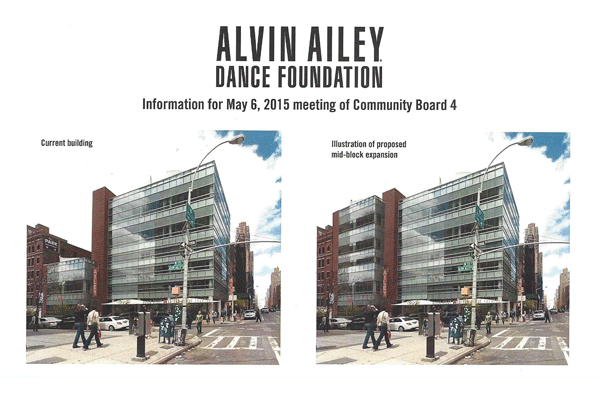
BY EILEEN STUKANE | The Alvin Ailey Dance Foundation needs more room to stretch. The Foundation — which encompasses the Alvin Ailey American Dance Theater, Ailey II, The Ailey School, Ailey Arts In Education & Community Programs, and the Ailey Extension — opened its home in 2004 in two buildings of The Joan Weill Center For Dance (405 W. 55th St. on the northwest corner of Ninth Ave.). However, the Foundation is currently cramped, and has applied to the NYC Board of Standards and Appeals (BSA) for a variance to build higher. Its request is making Community Board 4 (CB4), which has certain rules to follow, look a little like the bad guy.
At the May 6 full board meeting of CB4, Bennett Rink, the Foundation’s executive director, explained that since those buildings opened in 2004, Alvin Ailey has experienced “tremendous growth…the school has doubled in size. Our Extension program has proved to be wildly popular. We have to cancel classes at times when the building gets overcrowded, and we don’t have room for academic classes which are so essential to the program.” (In conjunction with Fordham University, the Ailey School is now able to offer a Bachelor of Fine Arts.)
A problem arises because the buildings fall within the Special Clinton District — between W. 41st and W. 59th Sts., west of Eighth Ave. — which has specific regulations for the area’s residential character. Those regulations were waived in 2002 when the Foundation received a variance to allow it greater height and floor area to accomplish its original goal of constructing the now-existing two buildings. As Rink explained, in today’s world, the Foundation needs “four additional studios, two new classrooms, and a small amount of office space,” which it could create by adding three floors to the smaller of its two adjacent buildings, the one at mid-block.
“This was an extremely difficult case for the (CB4 Clinton/Hell’s Kitchen Land Use) Committee. We love Alvin Ailey but they’ve applied to the BSA for variance. It’s a very strict process. We have to answer it,” explained Jean-Daniel Noland, the committee’s chair. The committee is required to respond to five issues, technically called “findings” — Unique Physical Conditions, Reasonable Return, Essential Character of Neighborhood, Self-Created Practical Difficulties, Minimum Variance Necessary — for each of the requested waivers, of which the Ailey Foundation had four: floor area ratio, lot coverage, height and setback, maximum number of employees. “We tried to respond as correctly as we could. We have nothing against Alvin Ailey,” said Noland.

Members of the Ailey Foundation watched as CB4 members voted to approve a nine-page letter to the BSA that would deny them three of the sought waivers — floor area ratio, lot coverage, height and setback. Back in 2002 the Foundation won a variance approval for the original 59,123 square foot building of 14 dance studios, offices and support space. The Foundation did not use all of the approved space. Left over from its initial variance, according the CB4 chair Christine Berthet, is the space to have approximately two more studios — but Rink clearly identified the need for more space than that. The application for variance states that 10,227 sq. ft. of additional space is required.
In committee, prior to the full board meeting, the Foundation had identified its desired 98 feet of building height (without setback) as consistent with the height of many existing buildings on surrounding blocks, even though the permitted height is 66 ft. Countering that statement, CB4 in its letter to the BSA, noted that the taller existing buildings were either built before the Special Clinton District regulations were instituted in 1978, or before height regulations were enacted for Ninth Ave. Also, the proposed height increase would make what is now the smaller building, the taller one, thereby setting a precedent for breaking the height limit of the District.
CB4’s letter also stated that the committee suggested that the Foundation seek alternate ways of meeting its need for space. At the Clinton/Hell’s Kitchen Land Use Committee meeting, a member of the Parc Vendome Condominium Board on W. 56th St. offered that the building had a 15,000 sq. ft. former health club space for rent. In addition, the committee suggested that the Foundation might expand in the back or reconfigure the existing space using the additional height from the first variance, but these suggestions were not acceptable.
At the May 6 meeting, both Rink and Robert Battle, artistic director, Alvin Ailey American Dance Theater, spoke about the importance of outreach, which had brought so many CB4 residents into the Ailey Extension programs. They warmly expressed how pleased they were to be part of the CB4 community. In a like manner, Noland spoke of the affection CB4 has for Alvin Ailey and how the board would like to find a space for them in the neighborhood without breaking the height limits. As in so many relationships, though, these two parties had to agree to disagree.
What happens next? Ryan Singer, executive director, NYC Board of Standards and Appeals, reiterated that a community board is required to address a specific list of “findings” for each waiver in a variance request. The recommendation of the BSA is considered in the light of these findings. “Each building is considered on its own merits in terms of: Does it meet the findings?,” said Singer. Before making a recommendation, the BSA will also hold a hearing. An applicant such as the Ailey Foundation has to notify property owners within a certain radius of its building site, approximately 20 days beforehand, that a BSA hearing will be held to address its application for variance.
A community board, office of a borough president, members of the City Council and NYC Planning Commission are notified. Anyone interested can testify at this open hearing. “If the board [BSA] denies an application, the applicant can file an appeal that goes directly to the New York State Court,” Singer explained. Meanwhile, CB4 and the Ailey Foundation will remain fond of each other but at odds.

































